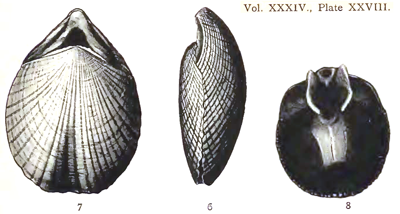 |
|||||
|
Genus Murravia Thomson, 1916. |
| [Type species= Terebratulina davidsoni Etheridge, 1876, p. 16.] |
Shell with incipient ventral uniplication, the dorsal valve flattened. Delthyrium partially closed by two lateral deltidial plates, leaving a sub- mesothyrid foramen which is margined anteriorly by the dorsal valve. Surface of valves ornamented with radiating ribs, which are continued as crenulations on the inner margins of the valves. Dorsal valve without a median septum, and with strong socket-ridges and a stout pyramidal cardinal process. Loop unknown, but crura springing from swollen bases below the inner anterior ends of the socket-ridges. Diagnosis of Thomson (1916) Small, thick shelled, thick, ovate, planoconvex, with wide hinge line, anterior commissure rectimarginate or unisulcate; surface costellate; foramen hypothyrid, deltidial plates disjunct. Pedicle collar present, myophragm may be present; cardinal process prominent, swollen anteriorly; socket ridges strong; internal margin of both valves crenulate Diagnosis from Treatise vol. 5 (2006) |
| Eocene - Present |
| Extant Species of Murravia |
|
| Diagnosis |
|
|

